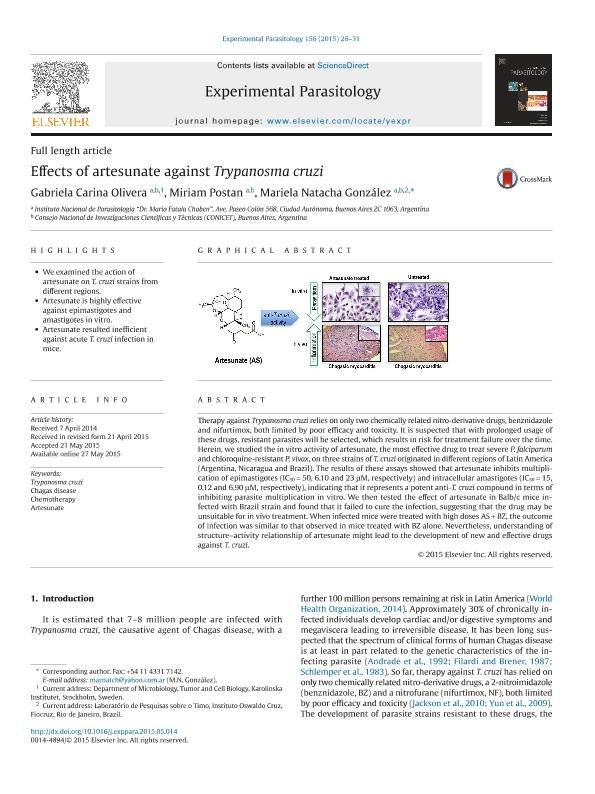Mostrar el registro sencillo del ítem
dc.contributor.author
Olivera, Gabriela Carina

dc.contributor.author
Postan, Miriam

dc.contributor.author
González, Mariela Natacha

dc.date.available
2018-04-10T18:24:06Z
dc.date.issued
2015-09
dc.identifier.citation
Olivera, Gabriela Carina; Postan, Miriam; González, Mariela Natacha; Effects of artesunate against Trypanosma cruzi; Academic Press Inc Elsevier Science; Experimental Parasitology; 156; 9-2015; 26-31
dc.identifier.issn
0014-4894
dc.identifier.uri
http://hdl.handle.net/11336/41560
dc.description.abstract
Therapy against Trypanosma cruzi relies on only two chemically relatednitro-derivative drugs, benznidazole and nifurtimox, both limited by poorefficacy and toxicity. It is suspected that with prolonged usage of these drugs, resistant parasites will be selected, which results in risk for treatment failureover the time. Herein, we studied the in vitro activity of artesunate, the mosteffective drug to treat severe P. falciparum and chloroquine-resistant P. vivax, on three strains of T. cruzi originated in different regions of Latin America(Argentina, Nicaragua and Brazil). The results of these assays showed thatartesunate inhibits multiplication of epimastigotes (IC50 = 50, 6.10 and 23 µM,respectively) and intracellular amastigotes (IC50 = 15, 0.12 and 6.90 µM,respectively), indicating that it represents a potent anti-T. cruzi compound interms of inhibiting parasite multiplication in vitro. We then tested the effectof artesunate in Balb/c mice infected with Brazil strain and found that it failedto cure the infection, suggesting that the drug may be unsuitable for in vivotreatment. When infected mice were treated with high doses AS + BZ, the outcomeof infection was similar to that observed in mice treated with BZ alone.Nevertheless, understanding of structure-activity relationship of artesunatemight lead to the development of new and effective drugs against T. cruzi.
dc.format
application/pdf
dc.language.iso
eng
dc.publisher
Academic Press Inc Elsevier Science

dc.rights
info:eu-repo/semantics/openAccess
dc.rights.uri
https://creativecommons.org/licenses/by-nc-sa/2.5/ar/
dc.subject
Trypanosoma Cruzi
dc.subject
Chagas Disease
dc.subject
Chemotherapy
dc.subject
Artesunate
dc.subject.classification
Salud Ocupacional

dc.subject.classification
Ciencias de la Salud

dc.subject.classification
CIENCIAS MÉDICAS Y DE LA SALUD

dc.title
Effects of artesunate against Trypanosma cruzi
dc.type
info:eu-repo/semantics/article
dc.type
info:ar-repo/semantics/artículo
dc.type
info:eu-repo/semantics/publishedVersion
dc.date.updated
2018-04-10T14:20:20Z
dc.journal.volume
156
dc.journal.pagination
26-31
dc.journal.pais
Estados Unidos

dc.description.fil
Fil: Olivera, Gabriela Carina. Dirección Nacional de Instituto de Investigación. Administración Nacional de Laboratorio e Instituto de Salud “Dr. C. G. Malbrán”. Instituto Nacional de Parasitología ; Argentina. Consejo Nacional de Investigaciones Científicas y Técnicas; Argentina
dc.description.fil
Fil: Postan, Miriam. Dirección Nacional de Instituto de Investigación. Administración Nacional de Laboratorio e Instituto de Salud “Dr. C. G. Malbrán”. Instituto Nacional de Parasitología ; Argentina. Consejo Nacional de Investigaciones Científicas y Técnicas; Argentina
dc.description.fil
Fil: González, Mariela Natacha. Dirección Nacional de Instituto de Investigación. Administración Nacional de Laboratorio e Instituto de Salud “Dr. C. G. Malbrán”. Instituto Nacional de Parasitología ; Argentina. Consejo Nacional de Investigaciones Científicas y Técnicas; Argentina
dc.journal.title
Experimental Parasitology

dc.relation.alternativeid
info:eu-repo/semantics/altIdentifier/doi/http://doi.org/10.1016/j.exppara.2015.05.014
dc.relation.alternativeid
info:eu-repo/semantics/altIdentifier/url/https://www.sciencedirect.com/science/article/pii/S0014489415001502
Archivos asociados
